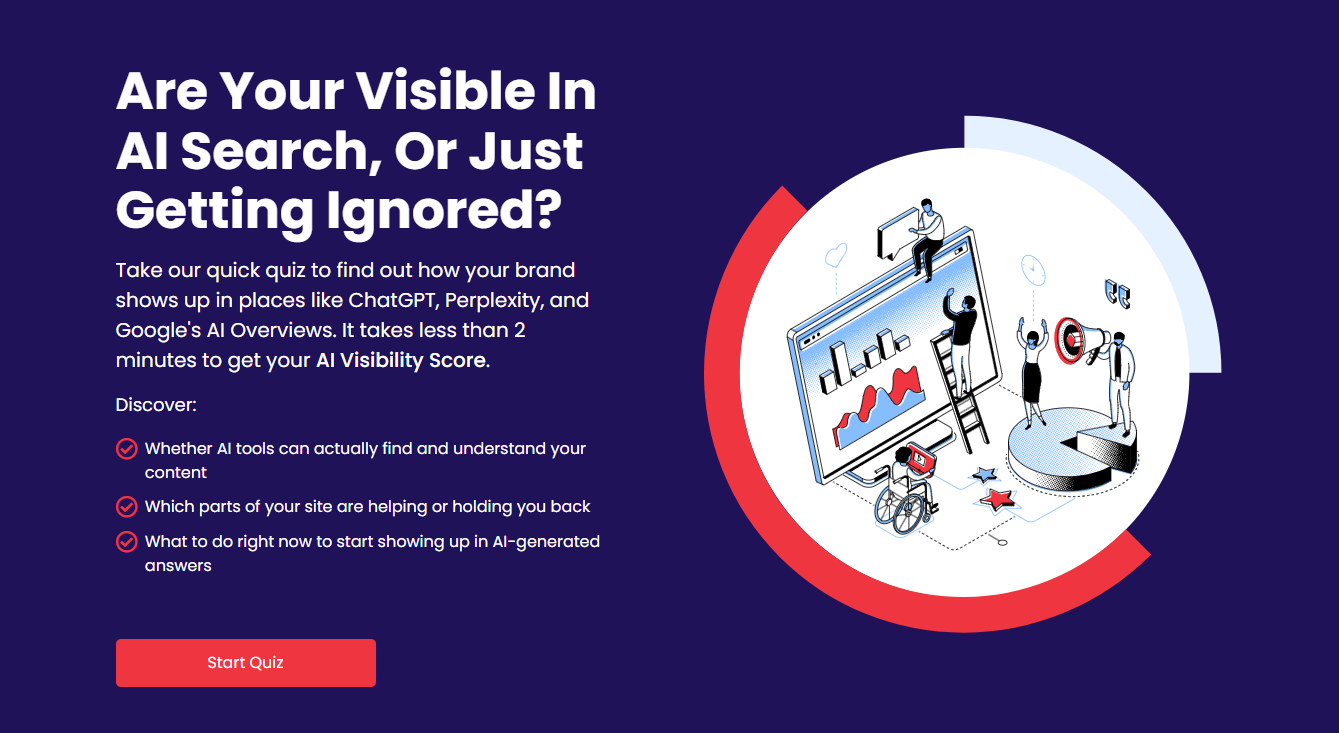Discover why your website traffic is dropping despite stable rankings. Learn about AI-powered zero-click search and Large Language Model Optimization (LLMO) to make your content visible and citable in AI answer engines.
Ever wonder why your website’s traffic is dropping even though your rankings are holding steady?
Blame AI-powered zero-click search. AI answer engines like Google SGE, ChatGPT, Bing Copilot, and Perplexity are now summarising your content right in their search results.
This means users are getting their answers without ever needing to click through to your site. No clicks, no sessions, and no visibility in GA4. Here, you’ll learn about Large Language Model Optimization (LLMO), a strategy designed to help AI discover, comprehend, and reference your content.
LangSync AI excels at helping brands appear in AI answers, leveraging a world-class team of AI experts who led breakthroughs at the major LLMs, reshaping the search landscape today.
Let’s get started.
First, What’s Behind the Drop?
AI Answers Without Clicks
AI tools have become the new middleman. People are asking ChatGPT, Gemini, or Perplexity for help, and these tools are pulling direct answers from websites like yours. SGE (Search Generative Experience) even shows AI summaries right on Google, so there’s no need to click through.
Here’s why this matters:
- A poll by Ignite Visibility found that 62% of people now use ChatGPT or Google Gemini to find a product or service. That’s about two-thirds of users bypassing search engines altogether.
- A 2024 Authoritas SGE study revealed that 94% of AI-generated results in Google SGE don’t match the top 10 organic links, and many summaries don’t include any citations at all. Even if you’re ranking high, AI might not mention you.
- 40% of consumers trust AI-generated results as much or more than traditional search engines when making buying decisions. You need to win trust in the AI’s answer box, not just on page one.
Real Example: A skincare brand was ranking #1 for “retinol vs bakuchiol,” but their traffic still dropped by 35%. It turned out their content was being quoted in SGE and ChatGPT results, without any link or credit back to them.
AI Summarises Your Content
LLMs pull meaning from your content and stitch together helpful answers. They’re solving the user’s question before your site loads. Helpful? Yes. But invisible to your analytics.
Real Example: A fintech blog defined “open banking” in their glossary. That exact text showed up in Perplexity’s answers. The brand was being cited in AI engines, even as their traffic stayed flat.
Ghost Mentions
Your tools can’t track AI-generated answers. Not Search Console. Not Ahrefs. Not SEMrush. If Bing Copilot or ChatGPT quotes you, you might never know.
Real Example: A food and nutrition blog noticed their daily traffic was stable but stagnant. After running a query in Perplexity for “best snacks for runners,” they saw one of their listicles paraphrased, with no citation or link. Their blog had become part of the AI answer without showing up in any analytics tool.
LLMO Is the New Visibility Strategy
What It Is
Large Language Model Optimization (LLMO) is how you make your content easy for AI tools to find, read, and reference. It’s not just about ranking. It’s about being included in AI-generated answers.
What It Does
- Makes your content retrievable by LLMs
- Adds semantic signals to help AI interpret meaning
- Boosts authority to earn citations
How to Build the Technical Foundation for AI Retrievability
Add Schema Everywhere
Use schema.org markup to structure your site. This helps AI models understand your content.
- Add the FAQ page to the common questions
- Use DefinedTerm on glossaries
- Include Organization with sameAs links to trusted profiles
Real Example: A law firm tagged FAQs and terms with schema. Soon, Bing Copilot began citing their definitions in contract-related queries.
Embed Your Content
Split your content into 100–300-word chunks. Turn those into embeddings using OpenAI or Cohere. Store them in Weaviate, Supabase, or Pinecone.
- Start with your highest-performing articles
- Use these in RAG (retrieval-augmented generation) systems
Real Example: An AI policy startup created a vector index of whitepapers. Within weeks, ChatGPT’s web browsing feature began citing its content.
Make Content AI-Friendly
Let AI systems reach your content:
- Keep RSS feeds and XML sitemaps fresh
- Don’t block reputable AI bots
- Use canonical URLs and metadata for clarity
Example: A medical education site submitted its RSS feed to Perplexity. Their anatomy guides started showing up in Perplexity answers a few weeks later.
Track the Signals
Filter GA4 traffic by referrers like chat.openai.com and bard.google.com. Use Langfuse or PromptLayer to monitor prompts and mentions.
Real Example: An analytics software company saw a traffic spike from chat.openai.com. Turns out Perplexity was linking to their cohort analysis article.
Reshape Content for AI Consumption
Break It Down
Turn long articles into Q&A pairs, checklists, and how-tos.
- Use H2/H3 questions
- Write bullet lists or numbered steps
- Keep each idea in its paragraph
Real Example: An HR tech company split their remote work guide into 12 FAQs. Perplexity picked up three in a post about hybrid policies.
Don’t Just Publish — Distribute
LLMs train on more than blogs. They crawl Reddit, Quora, Medium, Dev.to.
- Answer questions on Reddit and Quora using your blog insights
- Post trimmed versions to Medium and Dev.to
Real Example: A cybersecurity startup shared Reddit and Dev.to answer based on their whitepapers. These responses started showing up in ChatGPT and Claude citations.
Use Multimedia Smartly
AI understands more than just text.
- Add transcripts to every video
- Use alt text and descriptive names for images
- Create infographic-style visuals with clear labels
Real Example: A logistics company repurposed a webinar with subtitles and diagrams. Bing cited them in a summary of supply chain software.
Mirror the Prompt Style
Structure posts like common AI prompts.
- Start with questions like “How do I…” or “What’s the best way to…”
- Highlight takeaways in bold
- Keep it clean, focused, and direct
Real Example: A productivity app reformatted their blog into prompt-style Q&As. Within a few weeks, their tips were quoted in the SGE results.
Earn the Right to Be Cited
Get Featured
AI models prioritise trusted sources. Earn your mentions.
- Apply to “Top 10” lists
- Pitch journalists with your data or insight
- Use HARO and Featured to land expert quotes
Real Example: A DevOps company published a report on deployment failures. TechCrunch picked it up. Bing later cited them in “best DevOps tools” answers.
Link Your Brand to Trusted Profiles
Update entries on:
- Wikidata
- Crunchbase, GitHub
- Google Knowledge Panel
Add sameAs schema to connect your site to those profiles.
Real Example: A climate tech startup built a Wikidata entry and added it to their Organization schema. Within a month, they were cited by SGE in a climate tools roundup.
Provide Verifiable Data
Publish your studies, benchmarks, or insights. Make them structured and easy to reference.
- Label stat sections like “2025 Trends”
- Link data to source pages
- Create PDF and HTML versions
Real Example: An online video hosting company shared a benchmark report. Several stats were later pulled into AI summaries comparing average website bounce rates.
Check What AI Says About You
Ask ChatGPT, Perplexity, and Bing, “What is [Your Brand]?” Note any errors, gaps, or outdated info.
Real Example: A VC fund found that ChatGPT had their portfolio all wrong. They published a corrections blog and updated Wikidata. AI models are updated within a month.
FAQs
How can I tell if AI is using my content?
Just ask it. Try something like “What is [Your Brand]?” in ChatGPT, Perplexity, or Bing Chat. If it sounds like something straight off your site, you’re likely being quoted. For deeper tracking, filter GA4 by referrers like chat.openai.com or bard.google.com. Running your own AI models? Use tools like PromptLayer or Langfuse to see when your content is fetched.
Does adding a schema help me get cited?
It does — but it’s only part of the equation. Schema helps AI parse your content more clearly, but you also need authority and retrievability. Think of schema as speaking AI’s language. It makes your content easier to understand, but it doesn’t guarantee a shoutout.
Is it worth posting on Reddit, Quora, or Medium?
Definitely. A lot of AI training data comes from these public platforms. If you’re sharing valuable answers there, AI models are more likely to pick them up. Just make sure those same insights also live on your site so you still get the brand lift.
Are embeddings just for AI, or do they help with SEO too?
They’re not a direct SEO ranking factor, but embeddings help AI systems retrieve your content based on meaning, not just keywords. That boosts your chances of being cited in AI summaries, which can lead to more backlinks and mentions.
Final Thoughts On Why Your Traffic Is Done
Getting found today means more than ranking high.
It means being part of the answer. LLMO makes your content AI-visible and AI-citable, turning summaries, snippets, and comparisons into brand mentions and customer trust. It’s not about chasing clicks. It’s about becoming part of the conversation.
Take our free AI Visibility Scorecard to see how AI answer engines see your brand.


